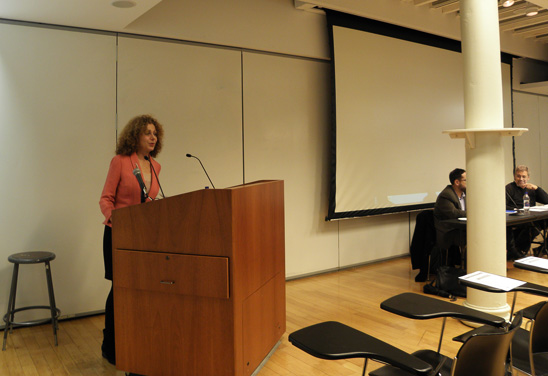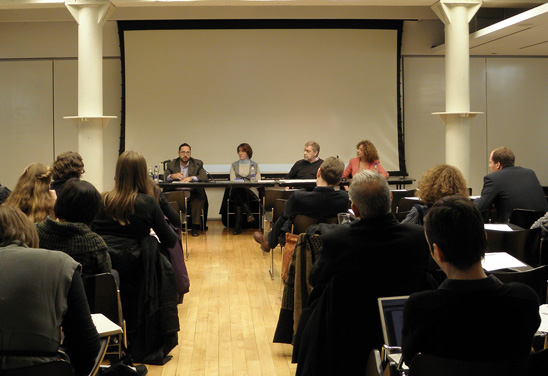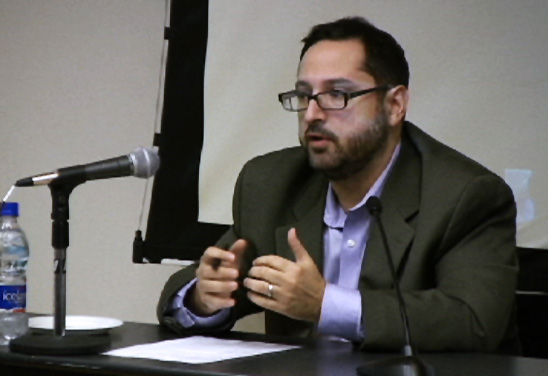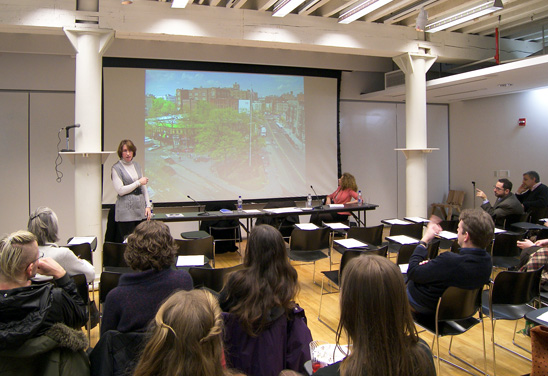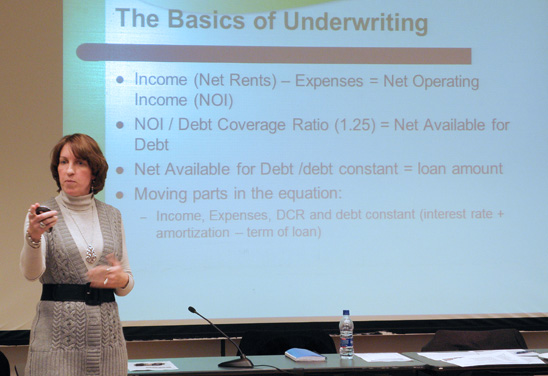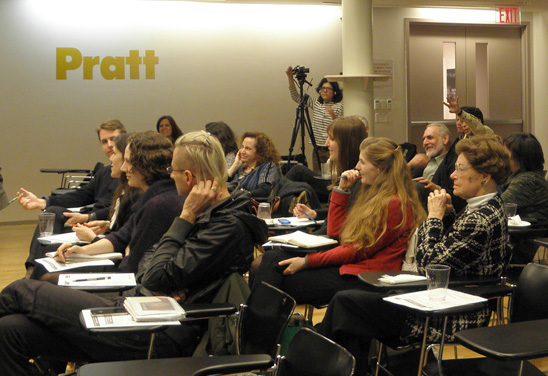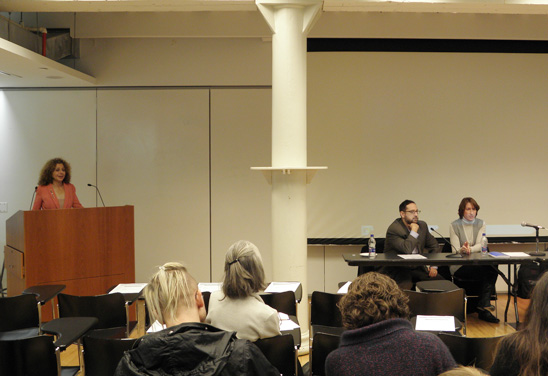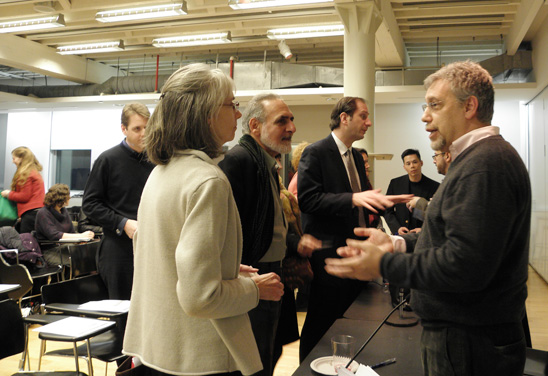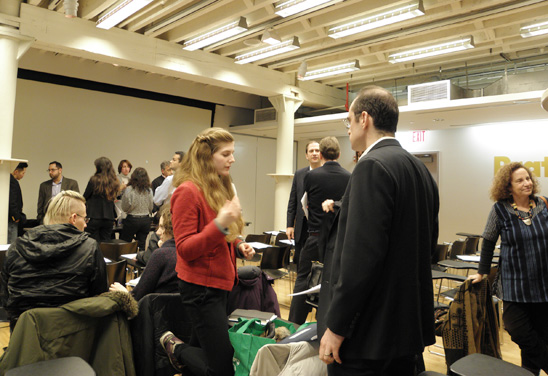Reimagining the Metropolis: Event Three — A Banker, A Lawyer & An Underwriter Walk Into A Bar
February 2, 2011
Reimagining the Metropolis: Event Three Wrap-up
A banker, a lawyer and an underwriter get serious about developing the means to assign monetary value to high performance properties, tracking and comparing their performance as well as tackling thorny issues of code enforcement and green building litigation. The speakers at this third panel, "No Joke" were Sam Marks, Vice President — Deutsche Bank Americas Foundation; Sadie McKeown, Senior Vice-President — The Community Preservation Corporation; Lawrence Schnapf, Principal — Schnapf Law Offices.
Nancy Anderson, Executive Director of the Sallan Foundation moderated the panel.
Sam Marks started the evening off with a look back at how affordable housing energy retrofits were financed five years ago. At that time Marks was working for Women's Housing and Economic Development Corporation and realized that many of the buildings in its portfolio could be retrofitted to be more energy efficient. "Five years ago this kind of thinking was revolutionary." Marks went on to explain how greater awareness of our fossil fuel dependence and climate change has opened up the opportunities for initiatives like PlaNYC and Greener Greater Buildings to gain traction. The tricky part in incentivizing retrofits, is overcoming the obstacles on the demand side. In NYC, rent stabilization eliminates the right to pass along building operating costs to tenants, and a skilled labour shortage make it difficult to aggregate demand. To change the split incentive equation, Marks proposed making the retrofits part of the housing marketplace and routinizing both the transactions and the measures taken. To accomplish this grand task the Deutsche Bank Living Cities Project put together a working group of stakeholders that developed a Request For Proposal for aggregating and amalgamating existing sets of benchmarking data that lenders would be comfortable to work with. At present, the main barrier for lenders is their lack of confidence in long-term energy savings. By assembling the data on over 12,000 unit of multi-family housing the Deutsche Bank Amercias Foundation report will identify out the best practices in use. The final piece of the project will involve reaching out to residential lenders and advisors about financing retrofits to see how current metrics and practices can be modified to include this groundbreaking data.
Sadie McKeown stressed that the world of underwriting is not as complicated as it seems, and went on to demystify an aspect of retrofitting buildings that often confounds even the most educated on building green. She asserted that if you added together all of the incentives currently available — from NYSERDA to Energy Star — you could impact just 1% of the building stock. While the housing market of five years ago would have allowed for extra financing to cover the marginal costs of retrofitting a building, many owners weren't opting for the long-term gain and were instead cashing out and moving on. The market today is under such scrutiny that many lenders are hesitant to make loans for energy retrofits. The solution, according to McKeown, lies in incorporating the financing for retrofitting into first mortgages. McKeown took the first step in this process by training her staff in the benchmarking process; later, McKeown was approached by Freddie Mac and Fannie May to discuss how they might train their in-house staff in benchmarking as well. McKeown emphasized that when the benchmarking is a routine part of the mortgage process, it starts to shift the overall attitude toward retrofitting buildings. Just as lead paint abatement and underground tank removal have become standard practices covered by first mortgages, McKeown believes that benchmarking can be viewed as simply another step in a mortgage loan application. Incorporating it into the process a home-buyer or developer not only secures the correct funding for the retrofits but also it creates the greatest overall impact on the efficiency of building stock. McKeown noted that there are some challenges to this change, such as the need to train building operators, to raise tenant awareness and the need to amass more concrete data (like the Living Cities Project) to propel the move toward incorporating benchmarking into the underwriting process. But the truth is, McKeown stressed, "the math doesn't lie."
Lawrence Schnapf started off by taking a deep look back on the seminal environmental legislation and litigation of the last four decades. He pointed to 1978 federal legislation to establish stricter national building codes, which would have reduced energy use in buildings. In 1981, after the election of President Reagan, the word "voluntary" was inserted in to the text and remains that way to this day. Over time, state and municipal laws picked up the slack. More than twenty-fiver years later, the U.S. Supreme Court decided in 2007 that carbon dioxide, the primary greenhouse gas emission, could be regulated by the federal Clean Air Act. Schnapf then made the case that the market needs more regulation — as well as the usual city tools of ordinances, zoning and incentives — to help owners see further than three years ahead (the average time span an owner will consider when thinking about building improvements). Schnapf noted that the current NYC Greener Greater Building benchmarking laws compels owners to show information about their building that they typically keep much closer to their chests and this his culture of non-disclosure may lead some owners to refuse compliance. However, a failure to file benchmarking information does not entail major consequences. If an owner does not benchmark his or her property the current penalty is a violation that would perhaps hinder refinancing at some future date but has little immediate consequence. Schnapf predicted that the Department of Buildings will work to change the structure of the law and add in a direct penalty for non-compliance. After outlining several pending court cases related to green buildings, Schnapf concluded by directly addressing the law students and lawyers in the audience. "Green building law is to this generation what Superfund law was to mine." Schnapf stressed that, "the economic incentives for greater efficiency in buildings means that green building is here to stay, regardless of any debate over climate change."
Event Resources
Sadie McKeown graciously made her presentation available for download:
Sadie McKeown (Sr. Vice President for Energy Initiatives, The CPC)
PDF Download [ 2.8 MB ] Green Multi-Family Financing
Event Video Selections
A Banker, A Lawyer & An Underwriter Walk Into A Bar (2011) Event Video
Livestream
Due to overwhelming interest in this Event a decision was made to broadcast via Livestream. The Livestream broadcast was archived for a certain amount of time at which point the video was deleted from the Livestream servers.

